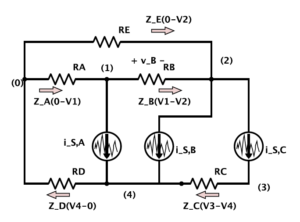The Course
In fall 2014, as the first course of my UofT M.Eng (course based engineering master’s), I took Modeling of Multiphysics Systems (ECE1254H), and have and have PDF notes for that course available (redacted: 196 pages, full version: 300 pages). You may contact me for the full version if you are not taking the course, and don’t intend to.
This course was taught by Prof. Piero Triverio.
This was a fun course. The basic theme was, “Well, we know how to solve circuit problems… so, let’s make all of physics look like circuit problems.” Along the way we covered lots of interesting numerical methods and topics, including:
- Tableau method
- modified nodal analysis
- LU decomposition
- conjugate gradient method
- sparse systems
- Newton-Raphson method
- Euler and trapezoidal rule, accuracy, stability
- Model order reduction of linear systems
- Modeling experimental data
Feel free to contact me for the complete version (i.e. including my problem set solutions) of these notes, provided you are not asking because you are taking or planning to take this course.
Contributing.
Should you wish to actively contribute typo fixes (or additions, editing, …) to this book, you can do so by contacting me, or by forking your own copy of the associated git repositories and building the book pdf from source, and submitting a subsequent merge request.
git clone [email protected]:peeterjoot/latex-notes-compilations.git peeterjoot cd peeterjoot for i in figures/ece1254-multiphysics ece1254-multiphysics matlab mathematica latex ; do git submodule update --init $i (cd $i ; git checkout master) done export PATH=`pwd`/latex/bin:$PATH cd ece1254-multiphysics make
I reserve the right to impose dictatorial control over any editing and content decisions, and may not accept merge requests as-is, or at all. That said, I’ll probably not refuse reasonable suggestions or merge requests.
Contents:
- 1 Nodal analysis
- 1.1 In slides
- 1.2 Mechanical structures example
- 1.3 Assembling system equations automatically. Node/branch method
- 1.4 Nodal Analysis
- 1.5 Modified nodal analysis (MNA)
- 2 Solving large systems
- 2.1 Gaussian elimination
- 2.2 LU decomposition
- 2.3 Problems
- 3 Numerical errors and conditioning
- 3.1 Strict diagonal dominance
- 3.2 Exploring uniqueness and existence
- 3.3 Perturbation and norms
- 3.4 Matrix norm
- 4 Singular value decomposition, and conditioning number
- 4.1 Singular value decomposition
- 4.2 Conditioning number
- 5 Sparse factorization
- 5.1 Fill ins
- 5.2 Markowitz product
- 5.3 Markowitz reordering
- 5.4 Graph representation
- 6 Gradient methods
- 6.1 Summary of factorization costs
- 6.2 Iterative methods
- 6.3 Gradient method
- 6.4 Recap: Summary of Gradient method
- 6.5 Conjugate gradient method
- 6.6 Full Algorithm
- 6.7 Order analysis
- 6.8 Conjugate gradient convergence
- 6.9 Gershgorin circle theorem
- 6.10 Preconditioning
- 6.11 Symmetric preconditioning
- 6.12 Preconditioned conjugate gradient
- 6.13 Problems
- 7 Solution of nonlinear systems
- 7.1 Nonlinear systems
- 7.2 Richardson and Linear Convergence
- 7.3 Newton’s method
- 7.4 Solution of N nonlinear equations in N unknowns
- 7.5 Multivariable Newton’s iteration
- 7.6 Automatic assembly of equations for nonlinear system
- 7.7 Damped Newton’s method
- 7.8 Continuation parameters
- 7.9 Singular Jacobians
- 7.10 Struts and Joints, Node branch formulation
- 7.11 Problems
- 8 Time dependent systems
- 8.1 Assembling equations automatically for dynamical systems
- 8.2 Numerical solution of differential equations
- 8.3 Forward Euler method
- 8.4 Backward Euler method
- 8.5 Trapezoidal rule (TR)
- 8.6 Nonlinear differential equations
- 8.7 Analysis, accuracy and stability (t 0)
- 8.8 Residual for LMS methods
- 8.9 Global error estimate
- 8.10 Stability
- 8.11 Stability (continued)
- 8.12 Problems
- 9 Model order reduction
- 9.1 Model order reduction
- 9.2 Moment matching
- 9.3 Model order reduction (cont).
- 9.4 Moment matching
- 9.5 Truncated Balanced Realization (1000 ft overview)
- 9.6 Problems
- 10 Harmonic Balance
- 10.1 Final Project
- 10.2 Abstract
- 10.3 Introduction
- 10.4 Background
- 10.5 Results
- 10.6 Conclusion
- 10.7 Appendices
- A Singular Value Decomposition
- B Basic theorems and definitions
- C Norton equivalents
- D Stability of discretized linear differential equations
- E Laplace transform refresher
- F Discrete Fourier Transform
- G Harmonic Balance, rough notes
- G.1 Block matrix form, with physical parameter ordering
- G.2 Block matrix form, with frequency ordering
- G.3 Representing the linear sources
- G.4 Representing nonlinear sources
- G.5 Newton’s method
- G.6 A matrix formulation of Harmonic Balance nonlinear currents
- H Matlab notebooks
- I Mathematica notebooks
- Bibliography
Changelog:
ece1254.V0.1.9-11.pdf, Sep 26, 2020 (commit fbcf82c816dff87c48a8a76e69f8189e5328d9ee)
- Update email address
- Spell check rules and spellcheck pass.
- Fix listing hyphenation
- thethe.py review.
- Brute force pruing of blank lines.
- Convert to 6×9 format, and fix all the corresponding gutter issues.
- add: backcover.txt
